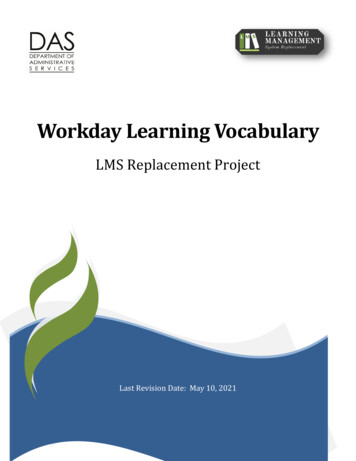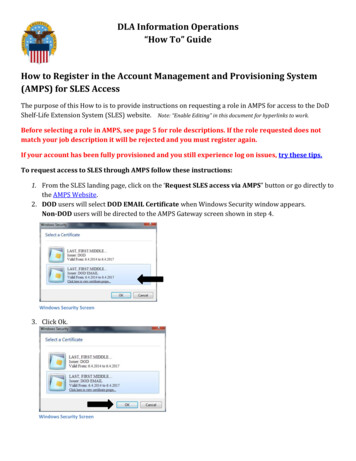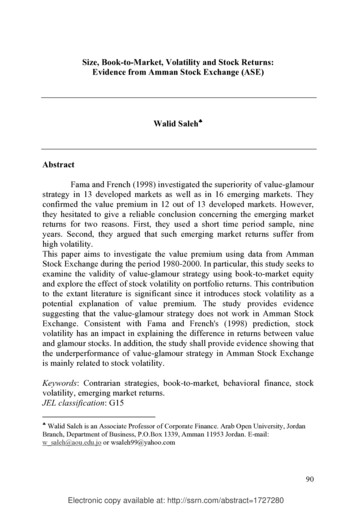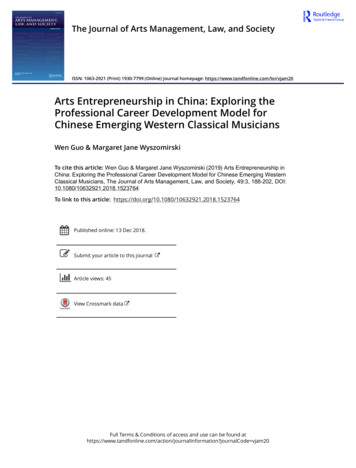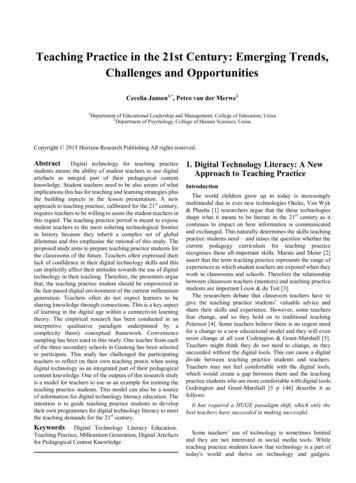
Transcription
The emerging role of the HR COOEmpowering HR leadership teamsto deliver more business valueDespite the proven benefits of HR transformation, businessexecutives and HR leaders alike continue to voice frustration with HR’s ability to deliver value. With no shortage oftalented people doing great work, what is the problem? Allsigns point to the need to rethink how HR organizationsdeliver on the promise of supporting the business — witha new role designed to drive performance improvementsacross the entire HR organization. The HR Chief OperatingOfficer.The business wants more — not less — from HRBusiness leaders today fully understand the value ofpeople. They can clearly articulate their top people priorities — and are more than willing to invest to get whatthey need. At the same time, Chief Human ResourcesOfficer (CHRO) leaders know they have to deliver whatthe business needs and wants. As a result, when businessand HR leaders sit down to work together, they are oftenfocused less on what needs to be done, and more on how.Predictably, business leaders want better, faster, and morecompliant HR services at a lower cost and an HR organization that can turn on a dime to support their everchanging business strategies and goals. Unfortunately,many HR organizations continue to struggle to meet thosedemanding requirements.The challenge of getting to “better, faster, cheaper, andmore agile” is daunting for any organization, but it isdoubly difficult for HR organizations, where many leadership teams still operate with structures and roles that havebeen in place for decades.The traditional model for HR leadershipToday, a typical corporate HR leadership team is led by aCHRO, and includes HR VPs for business units, HR VPs forCenters of Expertise (e.g., Compensation and Benefits), aVP for HR Operations, a VP for HR Technology, a head oflegal for HR, and an HR controller. Some leadership teammembers have dual reporting relationships, which caninclude direct lines to the CIO, CFO, CAO, or Chief LegalCounsel.Within this familiar structure, leadership team roles andresponsibilities are predictable. For example, HR VPs forbusiness units are naturally focused on business unit HRissues. Center-of-Expertise leaders concentrate on HRpolicies and programs. Leaders for HR Shared Services andTechnology manage operations and technology. And soon.In terms of operating model, HR leadership team memberstypically have their own budgets and resources, and areresponsible for developing an annual operating plan to
Traditional HR structureChief HR OfficerBusinessUnit AHRTechnologyHROperationsTalentCOEBusinessUnit BCompensationCOEBusinessUnit CBenefitsCOEHR LegalandComplianceHRControllerHR Special projectsand tyCOEsupport their priorities and projects. Implementation,however, is often the responsibility of an IT or SharedServices group, which may have its own resources andbudget. Members of the leadership team and their organizations provide implementation support as needed, suchas communications assistance or loaned resources.This traditional model works well as far as it goes — but itdoes not go nearly far enough. For example, when coordination is required across multiple functions and businessunits — such as merger integration or enterprise-widerollout of a new HR initiative — the model falls short. Inthose circumstances, integration is typically handled onan ad hoc basis through an informal network of “go-topeople” in the HR organization. The network steps upand pulls together to handle deals when they happen,with leadership often provided by an experienced teamof HR leaders. Success hinges on relationships and specialeffort rather than reliable processes, lines of authority, andstructure. As a result, there is often a gap between theexpectations of business leaders and what HR is set up todeliver.What’s not working?Most HR leaders can point to an innovative service theydeveloped to solve a critical business challenge. Theirstories have a familiar theme: the work required a lotof cooperation, goodwill, and effort by HR people whostepped up to the challenge to get something importantdone. The examples are hard to replicate because theyrequired huge commitments of time and energy.Similarly, many HR organizations have gone throughsuccessful HR transformation programs. By design, theseprograms come to an end point at which the transforma2tion of current HR services (or the development of new HRservices) stops. There is rarely a structure in place to sustainthe cycle of continuous performance improvement.These two scenarios illustrate a fundamental dilemma.On one hand, HR leaders understand that the businessunderstands the value of people and is willing to investin people more than ever before. Yet on the other hand,their HR organizations are not prepared to take advantageof this opportunity with their current structures, roles, andprocesses. HR leaders understand this dilemma and want asolution to this problem.Rethinking structureTo help HR organizations seize this business challenge, wepropose a simple step in the evolution of HR organizations:a division of responsibility between HR executives whofocus primarily on what needs to get done and those whofocus on how it gets done. That step requires creating anew, senior HR role — the HR Chief Operating Officer.The HR COO is the leader who focuses on how HR servicesare delivered, as well as the design, development, andimplementation of HR services. The person in this new rolewill drive efficiency, effectiveness, cost, and compliance forall HR services. The table on page three shows the divisionof responsibility in the HR leadership team when an HRCOO is established.Getting it doneLike any other leadership position, the role of the HR COOshould be defined to establish clear lines of responsibilityand reporting relationships. However, because solid linereporting relationships will not always exist, the influenceelement of the HR COO role should also be well defined.
Responsibilities Current HR service delivery, as well as driving improvements, to provide efficient, effective, and compliant HRservices Design, development, and implementation of new HRservices Development and implementation of business-focusedHR metrics Delivering reliable workforce data with correspondingworkforce reporting and analytics Development of the overall HR budget and analysis oftotal HR spend Development of a vendor management plan HR compliance and risk management Project management, including building capabilities forHR to manage projects such as Six Sigma in HR Development and implementation of an HR technologystrategy to support the business needsStructureThe HR COO role will generally have a combination ofsolid- and dotted-line reporting relationships. Below areexamples of reporting structures we have seen in organizations that have successfully embraced the role of the HRCOO. (See Samples 1 and 2.)InfluenceThe ability to exert influence is always important in leadership, but it is even more critical in structures with multipledotted-line reporting relationships. HR COOs and theirdirect and indirect reports need a solid understanding ofhow goals are set and how performance will be evaluated.This requires clarity about who influences and shapes dayto-day work, as well as longer-term career needs of theseindividuals.In search of Superman or Wonder Woman?At first blush, the list of qualities you’ll want from anHR COO may seem daunting. The role requires a mixof experience in HR, finance, technology, operations,and executive leadership – with a focus on HR servicedelivery and operations. That’s asking a lot – especially when you add in responsibilities for regulatory,risk, compliance budgets, and for managing change.But none of this means the HR COO has to be a superhero, not at all. The HR COO is part of your leadership team. The right person will balance and complement other executives, using influence and alliancesto get the job done.Strength through business resultsThe HR COO is a new and evolving role, but from organizations that have taken early steps in this direction,there are clear indications of common themes that driveeffectiveness.For starters, the HR COO role depends on having a clearand communicated mandate to drive HR service delivery,with responsibility for HR efficiency, effectiveness, andcompliance. As such, it requires full support of theExecutive Committee and the HR leadership team. TheHR COO will need to develop working relationships withmembers of the senior leadership team. One way to garnerthat support is to establish shared HR leadership teamgoals that are part of each member’s performance objectives.Division of HR leadership responsibilities with an HR COORoleKey responsibilitiesKey focusCHRO HR strategy Business-HR alignmentHR COO Drives implementation of new HR services HR operationsResponsible for ongoing HR service delivery HR efficiency, effectiveness, and compliance Drives efficiency, effectiveness, and compliance HR operating costsBusiness UnitHR VPs Develop business unit HR strategies and plans,drive business-corporate HR alignment Business unit HR strategy Business-HR alignment Develop HR policies and programs relatedto functional areas (Talent, Compensation,Benefits, Learning, etc.) HR policy and program effectivenessHR COE VPsProvides HR leadershipFocuses on Business-HR alignmentDevelops HR strategyOwns HR governance3
Sample 1: Formal and structured HR COO modelChief HR OfficerBusinessUnit AHR COELeader*BusinessUnit BBusinessUnit CCIO or CAO or COOHR COOTalent COEHR OperationsCompensationCOEHR TechnologyCIOBenefits COEHR ControllerCFOLearning COEHR Legal andComplianceLegalGlobal MobilityCOEHR VendorGorvernanceProcurementHR Specialprojects andProgram/PortfolioManagementSample 2: Influence-based HR COO modelChief HR OfficerBusinessUnit ABusinessUnit BBusinessUnit CHR COELeader*HR ControllerHR Legal andComplianceCIO or CAO or COOHR COOTalent COEHR VendorGovernanceLearningCOEHR Specialprojects andProgram/PortfolioManagementGlobalMobility COE*Centers of Expertise (COEs) may be integrated under a COE leader in a model similar to the HR COO4Procurement
Looking aheadTo put it simply, the HR Chief Operating Officer is not arole that someone can be phased into over time. Nor canit be piloted. It requires a depth of conviction from CHROswho know they are not yet delivering the services that thebusiness needs.In the months and years ahead, more and more CHROswill embrace the HR COO model as they strive to crackthe code for operational excellence in HR service delivery.Recognizing that even the best people cannot excel in asub-optimal operating model, the will make the call thatonly leaders can make — to change the operating modelof the HR organization to harness the power of how.For more information, please contact:Robin LissakPrincipalDeloitte Consulting LLPrlissak@deloitte.comJason GellerPrincipalDeloitte Consulting LLPjgeller@deloitte.comAbout DeloitteDeloitte refers to one or more of Deloitte Touche Tohmatsu Limited, a UK private company limited by guarantee, and its network of member firms,each of which is a legally separate and independent entity. Please see www.deloitte.com/about for a detailed description of the legal structure ofDeloitte Touche Tohmatsu Limited and its member firms. Please see www.deloitte.com/us/about for a detailed description of the legal structure ofDeloitte LLP and its subsidiaries.Copyright 2010 Deloitte Development LLC. All rights reserved.Member of Deloitte Touche Tohmatsu Limited5
Jason Geller Principal Deloitte Consulting LLP jgeller@deloitte.com. Created Date: 1





